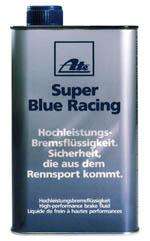ATE® Super Blue (DOT 4) has a dry boiling point of 536F and a wet boiling point of 396F. ATE Super Blue is identical in specification to the ATE TYP 200 brake fluid.
ATE Super Blue is compatible and will mix with most DOT3, DOT4, or DOT 5.1 Fluids.
This top-of-the-line product lies 20 °C over the DOT 5.1 standard and surpasses this standard in nearly all the other requirements as well. This means that cars can go without a brake fluid change for up to 3 years while products with a lower wet boiling point have to be replaced considerably more often (e.g. DOT 3 products should be replaced annually).
The overall high dry and wet boiling points make this fluid an excellent choice for street driven vehicles where brake fluid is flushed less frequently than in racing cars.
Also, the blue tint of the fluid makes bleeding brakes easy! You can easily tell when you have flushed out the older fluid.
TIP: Racers frequently will alternate fluid flushes using both the SuperBlue and TYP 200 (Amber). The identical specifications of the fluid and difference in color makes it easy to know when you have completely flushed old fluid out of the system.
Due to the extreme operating temperatures of a high performance brake system, standard 'off-the-shelf' brake fluids are not recommended. Of critical importance in determining a fluids ability to handle high temperature applications is the Dry Boiling Point and compressibility.
The Dry Boiling Point is the temperature at which a brake fluid will boil in its virgin non-contaminated state. The highest temperature Dry Boiling Point available in a DOT 3 fluid is 572 F
The Wet Boiling Point is the temperature a brake fluid will boil after it has been fully saturated with moisture. The DOT 3 requirement for wet boiling point is a minimum temperature of 284 F.
There are many ways for moisture to enter your brake system. Condensation from regular use, washing the vehicle and humidity are the most common, with little hope of prevention. Glycol based DOT 3 & 4 & 5.1 fluids are hygroscopic; they absorb brake system moisture, and over time the boiling point is gradually reduced.
We do not recommend using DOT 5 fluid in any racing applications. DOT 5 fluid is not hygroscopic, so as moisture enters the system, it is not absorbed by the fluid, and results in beads of moisture moving through the brake line, collecting in the calipers . It is not uncommon to have caliper temperatures exceed 200 F, and at 212 F, this collected moisture will boil causing vapor lock and system failure. Additionally, DOT 5 fluid is highly compressible due to aeration and foaming under normal braking conditions, providing a spongy brake feel. DOT 5 fluid is best suited for show car applications where its anti-corrosion and paint friendly characteristics are important.
Whenever you add fresh fluid to your
existing system (never mix fluids of different DOT classifications), it immediately becomes contaminated,
lowering the boiling point of the new fluid.
For maximum
performance, start with the highest Dry Boiling Point available,
flush the system completely, and flush it regularly, especially
after severe temperatures have been experienced.
Brake
system capacities vary on differing vehicles. Typically 2
Pints (or approximately 1 Liter) should be sufficient to completely
flush the old fluid and replace with new. We recommend 4 Pints
or 2 Liters of Fluid to be certain that your system is completely
flushed of old fluid- and this also allows for some extra
fluid to spare.

